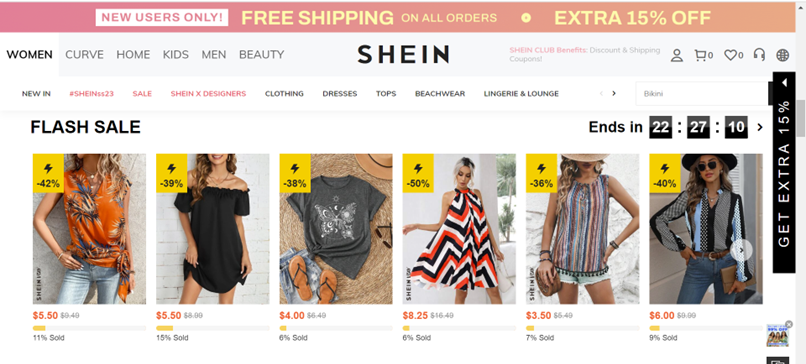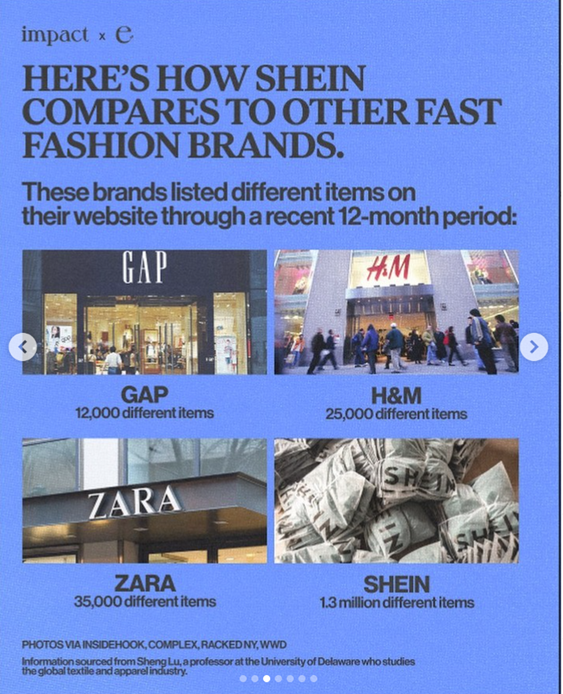
The fast fashion behemoth has overtaken the apparel market via its incredibly cheap imports. But SHEIN also faces a host of accusations that it appears to want to brush aside.
SHEIN, the Chinese fast fashion direct-to-consumer online retailer popular with Gen Z for its uber-cheap, super trendy clothing, is in a bit of a quandary right now.
On the one hand, it is the most popular clothing brand in the world. SHEIN posted a 2022 revenue of $22.7 billion and is projecting a $60 billion revenue by 2025, which would exceed the existing combined annual sales of fast fashion competitors H&M and Zara.
On the other hand, all that profit has brought a lot of negative attention onto the retailer and its litany of bad practices, including from bipartisan lawmakers concerned about its alleged reliance on forced labor and dodging of U.S. trade enforcement, among other worries. And that may be getting in the way of SHEIN’s plans for further global domination, including through a potential public offering.
What then, is the company to do? Take a real hard look at its own practices and implement reforms to become a more responsible company?
Nah.
Instead, it looks like SHEIN is conducting a public relations campaign to refurbish its image in an attempt to convince everyone that everything is above board. There’s this piece in D.C. insider publication Politico published over the weekend; Reuters has a similar story. But those articles are far more nuanced than this New York Times feature from May, which promoted SHEIN’s work with “independent designers,” while failing to spend much time addressing SHEIN’s history of… stealing from designers.
It’s not just flashy news stories SHEIN is after. Politico reports that SHEIN has hired Washington lobbyists, who are charged with pushing back against the most worrisome accusations facing the brand, mainly that it depends on forced Uyghur labor to make its products. Lab tests from a Bloomberg investigation showed that cotton used in SHEIN clothes were linked in Xinjiang, the region in China where forced labor runs rampant. But now SHEIN is out with its own lab findings, conducted by a third party vendor, and the company told Politico that “nearly 98 percent of its cotton did not come from Xinjiang or other regions blocked under U.S. law.”
Not everyone is buying it.
“I’m not sure that mostly-not-made-with-slave-labor is a good advertisement,” said Rep. Mike Gallagher (R-Wis.), chair of the House Select Committee on the Chinese Communist Party, who recently joined ranking member Rep. Raja Krishnamoorthi (D-Ill.) in demanding answers from the brand about its supply chain.
Even if the company’s findings are accurate — and that’s a big IF — there are still plenty of other reasons why both lawmakers and consumers should be leery of SHEIN. Here’s a quick primer.
SHEIN’s Forced Labor and Sweatshop Accusations
It’s not just cotton to worry about when it comes to SHEIN’s production. As Politico noted, the majority of SHEIN’s products are actually made from polyester, which is far more difficult to trace. Meanwhile, even when the Chinese factories where SHEIN clothes are produced are not utilizing forced labor, they still appear to be operating under deplorable sweatshop conditions. A Channel 4 documentary found workers “regularly work 18-hour days, earning just 2 cents per item they produce.” Workers typically work seven days a week, too.
The sad truth is that there probably isn’t a way for SHEIN’s business model to work otherwise. Remember that SHEIN is pumping out incredibly cheap clothes at a shockingly fast rate. It added between 2,000 and 10,000 styles on its app each day between July and December 2021. Compare that to apparel companies that prioritize the well-being of their employees; clothing is produced in small batches, and it costs more. The only way to make that much stuff so quickly and sell it for so cheap and still make a profit is for SHEIN to exploit the labor of the people who make its clothes.
SHEIN’s Dodging U.S. Customs and Taking Advantage of a Trade Loophole
The truth is, we’d probably find out a lot more about SHEIN’s supply chains if U.S. Customs officials were able to inspect the brand’s products more often. But SHEIN is gaming the system through its direct-to-consumer model, which is allows it to ship orders directly from China to customers in the United States. That makes it exceedingly difficult for inspectors charged with enforcing the Uyghur Forced Labor Prevention Act, the law that bans products made whole or in part in Xinjiang, from examining all of the stuff SHEIN ships to the United States every year.
SHEIN is also taking advantage of the U.S. de minimis standard, which waives tariffs for any shipments to the United States valued under $800. Since most individual packages from SHEIN are less than $800, it is sending the vast majority of its goods into the U.S. duty-free. That puts retailers who import their products via traditional routes like cargo ships at a disadvantage, since all those companies pay the tariffs. And since those tariffs are partly in place to help level the playing field, the de minimis loophole is handing SHEIN an unfair advantage over America’s own manufacturers and factory workers.
Rep. Earl Blumenauer (D-Ore.) introduced legislation last year to tackle the de minimis loophole and is expected to re-introduce that bill this Congressional session. It almost certainly will garner widespread bipartisan support; Congress would be wise to pass it.
SHEIN’s Bad Health and Environmental Record
There’s absolutely no doubt that the entire fashion industry — and the rise of fast fashion in particular — has exacerbated the climate crisis. Advocacy group Fashion Revolution finds that the industry produces 2.1 billion tons of greenhouse gas emissions every year, a number expected to rise to 2.7 billion tons by 2030. On top of that, the industry creates an incredible amount of waste. Throwaway fashion has polluted the planet, with 92 million tons of textile waste ending up in landfills every year.
SHEIN took the fast fashion model and dialed it up, exacerbating the problem. Take a look at this chart shared on Instagram by the nonprofit group re/make, which advocates for a more responsible fashion industry:

SHEIN just makes so much stuff, most of it from virgin materials. Again, compare it to “Slow Fashion” brands, which are thoughtful about the materials they use. It takes longer, costs more, and far less is made. But even SHEIN’s other fast fashion competitors don’t churn out as much product; it truly is in a bad-for-the-Earth league of its own.
The health of the planet isn’t the only health concern, either.
There’s a whole lot of chemicals found in fast fashion, and SHEIN products are among the worst offenders. An investigation by Greenpeace showed seven out of 47 SHEIN products it tested contained hazardous chemicals banned by the European Union; other studies have found lead in children’s products sold by SHEIN.
SHEIN Steals Intellectual Property
Along with SHEIN’s big PR push this week, there were other headlines about the company in the news. As it turns out, SHEIN was selling rip-offs of high end brands like Air Jordan, YEEZY, Foam Runners, Balenciaga shoes and MSCHF Big Red Boots. SHEIN took many of the shoes down, blaming third-party sellers.
This wasn’t the first time SHEIN has been accused of stealing designs. The brand has faced dozens of lawsuits from designers and others accusing it of intellectual property theft, and those are just the folks willing to take on the company in court. The list of accusations is long and varied: A British nail artist says SHEIN stole her designs; an Australian designer said SHEIN copied her designs of inclusive activewear. It all makes SHEIN’s new PR embrace of independent designers all the more rich.
***
There are additional concerns about SHEIN, from worries about how the brand is utilizing user data to its marketing practices, which are primarily aimed at young users. And despite SHEIN’s best efforts, it’s unlikely that the criticism will go away; it’s a safe bet that the company’s actual goal for this PR campaign is to create enough pushback that legislative efforts to tackle some of its egregious practices will fade or be defeated altogether. After all, people have been criticizing fast fashion in general for years, but people are still buying up all that cheap clothing.
None of this should deter lawmakers. It is entirely reasonable, for example, for Congress to act to close the de minimis loophole and eliminate the incredible unfair advantage that SHEIN has exploited. It also makes complete sense to allocate more resources to ensure U.S. Customs officials have tools at their disposal to fully enforce the Uyghur Forced Labor Prevention Act — something that SHEIN shouldn’t be afraid of if it is truly serious about not sourcing from Xinjiang.
Consumers also have a role to play. While fast fashion is ubiquitous these days, choosing to support more responsible brands whenever possible — like these Made in America options! — can go a long way in building a viable and more sustainable way of doing things. At the very least, staying away from SHEIN is a good start.
